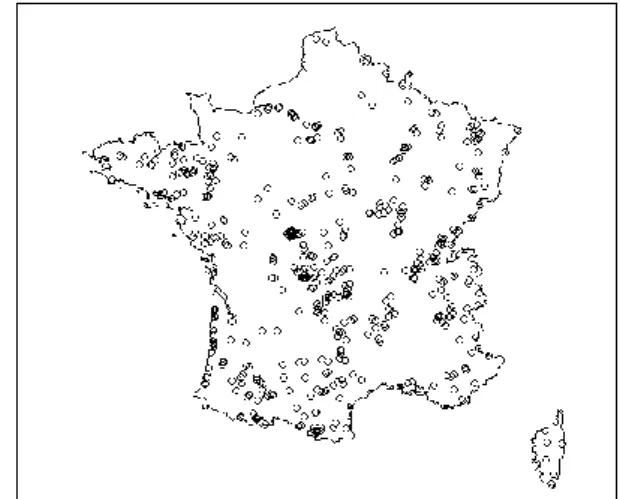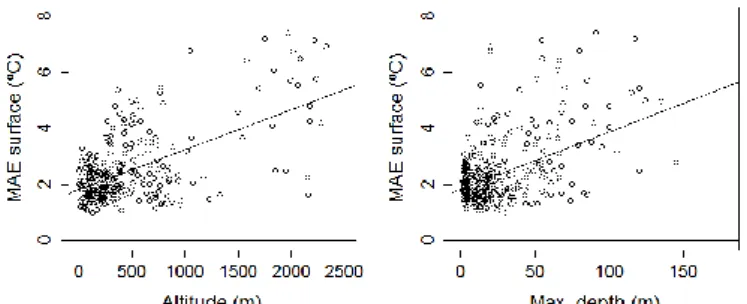HAL Id: hal-02069202
https://hal.archives-ouvertes.fr/hal-02069202
Submitted on 15 Mar 2019HAL is a multi-disciplinary open access archive for the deposit and dissemination of sci-entific research documents, whether they are pub-lished or not. The documents may come from teaching and research institutions in France or abroad, or from public or private research centers.
L’archive ouverte pluridisciplinaire HAL, est destinée au dépôt et à la diffusion de documents scientifiques de niveau recherche, publiés ou non, émanant des établissements d’enseignement et de recherche français ou étrangers, des laboratoires publics ou privés.
Application of the General Lake Model (GLM) to a
large set of French water bodies
J. Prats, N. Reynaud, P.A. Danis
To cite this version:
J. Prats, N. Reynaud, P.A. Danis. Application of the General Lake Model (GLM) to a large set of French water bodies. 5th IAHR Europe Congress ”New Challenges in Hydraulic Research and Engineering”, Jun 2018, Trente, Italy. pp.337-338. �hal-02069202�
ABSTRACT
We present an ongoing project whose objective is the application of the General Lake Model to study the thermal characteristics and long-term behaviour of the 476 largest French inland water bodies.
1 INTRODUCTION
Water temperature is one of the physicochemical parameters supporting the biological parameters in the Water Framework Directive. As such, it must be taken into account in the assessment of the ecologi-cal state or potential of inland water bodies.
Previously, though, it is necessary to know the thermal behaviour of water bodies under natural conditions in the case of lakes, taking into account interannual and intra-annual variability. For artifi-cial and heavily modified water-bodies it is neces-sary to determine the thermal behaviour under the best ecological potential considering management technical constraints.
Although the availability of high quality tempera-ture data is increasing thanks to continuous meas-urement systems, it is limited to a low number of water bodies. Instead, in the context of the recent meteorological conditions and different climate change scenarios, we intend to use the General Lake Model (GLM) to simulate the thermal behaviour of French water bodies under the scenarios of observed anthropogenic eutrophication and of no anthropo-genic eutrophication. The effect of eutrophication will be approximated by way of water transparency.
2 DATA
2.1 Complete set of water bodies
This project aims to simulate water temperature in a set of 476 French water bodies of surface area above ~0.5 km2, including 328 reservoirs, 64 natural lakes, 42 ponds, 36 gravel pit lakes and 6 quarry lakes.
Morphometric data (depth, surface area, and vol-ume), geographic data (altitude, latitude, and longi-tude) and Secchi depth data were extracted from the French national lakes database (“plan_deau”), main-tained by Irstea. Meteorological data were extracted from the 8 km resolution SAFRAN reanalysis [1], covering the French territory. Inflows were simulat-ed by the model Loieau [2] and inflow characteris-tics were extracted through GIS processing from the CARTHAGE hydrographic database and DEM.
The main sources of data for the calibration of the model and the validation of the simulations were: 1) vertical in situ profiles of the French operational control and monitoring networks; and 2) satellite temperature measurements from the data set LakeSST [3].
Figure 1. Location of the 476 studied water bodies.
2.2 Individual sites
Some sites were selected to test the application of GLM on a site by site basis. The criterion to select these water bodies was the existence of continuous temperature measurements and records of inflows and outflows. In some cases, regular Secchi depth measurements were also available. These data were provided by environmental agencies, water man-agement bodies, enterprises, research groups, etc. Meteorological data were obtained from nearby me-teorological stations. Efforts are under way to in-crease the number of water bodies in this data-rich set.
Application of the General Lake Model (GLM) to a large set of French
water bodies
J. Prats, N. Reynaud
UR RECOVER, Pôle AFB-Irstea hydroécologie des plans d’eau, Irstea, France
P.-A. Danis
3 THE GENERAL LAKE MODEL (GLM)
The General Lake Model [4] simulates the vertical structure of water temperature, salinity and density in fresh water bodies. It is a physically-based model that takes into account surface heat exchanges, in-flows and outin-flows and the main mixing and diffu-sion processes. We modified GLM v. 2.2 so that it could use a variable light extinction coefficient as input. GLM was already applied to simulate lake water temperature in a regional scale in [5], with an RMSE of 1.74 ºC for the surface temperature.
4 HYDRODYNAMIC SIMULATIONS
We coded a set of functions in Python 2.7 to read the available data and prepare the GLM input files. We followed a double approach depending on the set of water bodies used. At this stage, simulations were run without any calibration.
4.1 Complete set
We used a common simulation framework for the water bodies in the set. We used a constant light ex-tinction coefficient. For reservoirs we assumed wa-ter was extracted from the bottom and that the out-flow was equal to the total inout-flow. For the other types of water bodies, we assumed water left through a surface effluent, simulated as an overflow. The simulation period was 1999-2008, since Loieau sim-ulated flows were only available till 2008.
These simulations will help us study the general error structure of the model. Preliminary results show a dependency of the mean absolute error (MAE) of surface temperature on lake altitude and/or lake depth (altitude and depth are positively correlated, Kendall’s τ = 0.42, p-value < 2.2e-16).
Figure 2. MAE of surface temperature as a function of lake alti-tude (left) and maximum lake depth (right).
4.2 Individual sites
The configuration of the model is adapted to the characteristics of the water body and available data. When enough data is available, we use a variable
light extinction coefficient and the recorded forcing data.
We also ran additional simulations by replacing a forcing variable by the equivalent hypothesis used in the complete set simulations, to test the sensitivity of the model to the different hypothesis.
5 PERSPECTIVES
Our next steps include the determination of the cause of the observed error patterns, whether it is the model or the forcing hypotheses. After improving the simulations thanks to this information and cali-brating the model, it will be possible to run simula-tions based on different water quality and climate change scenarios.
6 ACKNOWLEDGE
We thank Louise Bruce for advice on how to modify GLM to implement a variable light extinc-tion coefficient input. We thank all the providers of data for individual sites. We thank Météo-France for the Safran and station data. We thank Nathalie Fol-ton for providing the inflow data. This project is funded by the French Agency for Biodiversity.
REFERENCES
[1] Vidal, J.-P., Martin, E., Franchistéguy, L., Baillon, M. and Soubeyroux, J.-M., 2010. A 50-year high-resolution atmospheric reanalysis over France with the Safran system. International Journal of Climatology, 30, 1627-1644.
[2] Folton, N., 2012. Cartographie nationale des débits de référence d'étiage. La méthode LOIEAU. IRSTEA, Aix-en-Provence.
[3] Prats, J., Reynaud, N., Rebière, D., Peroux, T., Tormos, T. and Danis, P.A., 2017. LakeSST: Lake Skin Surface Temperatures in French inland water bodies for 1999–2016 from Landsat archives. Earth System Science Data Discussions, 2017, 1-33.
[4] Hipsey, M.R., Bruce, L.C. and Hamilton, D.P., 2014. GLM - General Lake Model: Model overview and user information. The University of Western Australia, Perth, Australia.
[5] Read, J.S., Winslow, L.A., Hansen, G.J.A., Van Den Hoek, J., Hanson, P.C., Bruce, L.C. and Markfort, C.D., 2014. Simulating 2368 temperate lakes reveals weak coherence in stratification phenology. Ecological Modelling, 291, 142-150.

